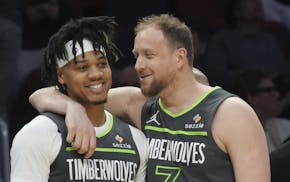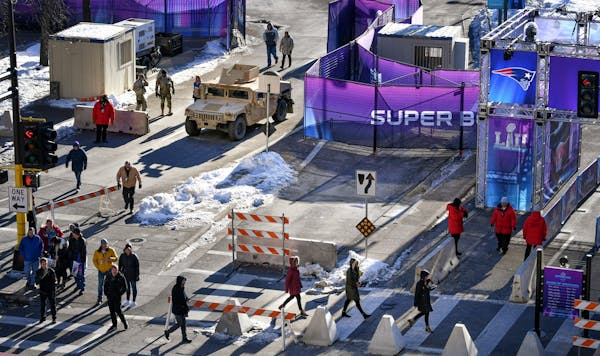Bill Parcells won two Super Bowls as a head coach. Now, he's like many NFL fans watching on television each week, still transfixed by the games, often perplexed by them, too.
"The officiating is almost an impossible job now; there are so many variables," Parcells said. "And the replay situation is out of control. You've got people looking at the replay, and they can't even get it right. So it must be too complicated."
That's a good word to describe the NFL's popularity — it's complicated — as Commissioner Roger Goodell prepares to hold his annual Super Bowl week news conference Wednesday in Minneapolis.
In a recent Gallup Poll, 37 percent of Americans named football their favorite sport, with basketball a distant second at 11 percent. Last year's Super Bowl drew an average audience of 111.3 million viewers, and advertisers spent as much as $5 million for each 30-second TV commercial.
But television ratings for NFL games have fallen for two straight years — by 8 percent in 2016 and 9.7 percent this year, according to Nielsen.
Some blame oversaturation, with Thursday night games and Sunday morning games from London cluttering the menu. Some fans took issue with NFL players kneeling during the national anthem to protest racial inequality. President Donald Trump fanned the flames with sharp criticism of those protests.
Meantime, scientists studying brain tissue at Boston University continue to diagnose former players, posthumously, with chronic traumatic encephalopathy, or CTE, a progressive, degenerative disease. There were 281 reported concussions in the NFL this season, the most since the league began sharing the annual number in 2012.
Goodell, whose new contract extension will pay $40 million per year, remains a lightning rod for criticism over the league's handling of these and other issues.
"[The ratings decline] tells you things," Parcells said. "That tells you that the public interest is waning somewhat. But I watch every Sunday, so my TV ratings haven't gone down."
Why the ratings drop?
Hall of Fame coaches aside, an average of 1.6 million fewer people watched each game this season. Last week's Patriots-Jaguars game was the lowest-rated AFC Championship Game in three years, and the Vikings-Eagles game was the lowest-rated NFC title game since 2009.
Even with ratings down, Goodell said that 37 of the 50 highest-rated TV shows in 2017 were NFL games. For the seventh consecutive year, "Sunday Night Football" was No. 1.
The NFL also endured a season in which several star players, including Aaron Rodgers, T.J. Watt, David Johnson and Odell Beckham Jr., were lost because of injuries.
"From our standpoint, the NFL viewership is dominant and will continue to be dominant," Goodell told the Star Tribune's Sid Hartman.
With the league's major television contracts expiring in 2021 and 2022, the NFL holds less leverage with the networks for the soon-to-come negotiations.
"If you really boil it down, I think the NFL's gotten greedy," former Vikings linebacker Ben Leber said. "There's too much football on television. I wish they'd take a step back and get rid of Thursday games and keep Sundays and Mondays just for the NFL. Get back to the way it was."
Many fans' viewing habits have changed. Millions play fantasy football and prefer watching highlight plays broadcast on "NFL Red Zone" more than the actual games on network TV because they get quicker access to scoring plays.
Ball State telecommunications professor Dom Caristi said the NFL's ratings decline has nothing to do with presidential tweets or player protests. He blames a diluted marketplace with so many more options for viewers.
"There's no such thing as must-see TV anymore," Caristi said. "The Super Bowl's as close as you can get."
The average NFL game lasted 3 hours, 7 minutes last season, which was five minutes longer than 2008. The league made minor adjustments, including tightening the halftime window. Seven weeks into the season, the results had trimmed just 26 seconds, according to Forbes.
"One thing that still drives me crazy is the lack of flow," Leber said. "Sometimes with the number of designated TV timeouts, the unforeseen injuries, and everything gets reviewed. I think that annoys fans. Sometimes it annoys me, and I'm not even a millennial or a young viewer."
The protest effect
Rich Reckinger, 55, saw his first game at U.S. Bank Stadium on New Year's Eve, when the Vikings defeated the Chicago Bears. He said his Vikings passion hasn't wavered but his overall NFL interest is down.
"The national anthem protest has a lot to do with it," Reckinger said, echoing the thoughts of others interviewed at that game. "I find myself not watching as much on Monday nights or Sunday nights."
The protests started in 2016, when former San Francisco quarterback Colin Kaepernick sat and then knelt during the anthem, saying he was protesting racial inequality and police brutality. A few players were still kneeling during the anthem early this season, when Trump took his stand.
At an Alabama rally in September, Trump said, "Wouldn't you love to see one of these NFL owners, when somebody disrespects our flag, to say, 'Get that son of a bitch off the field right now — out! He's fired. He's fired!' "
The next Sunday, more than 200 players and multiple owners got involved, with some kneeling and others locking arms in unison. Fans booed.
In his Star Tribune interview, Goodell stressed the respect the NFL has for the country and military, adding, "We also wanted to certainly understand what our players were talking about."
Reckinger said Goodell had the authority to make players stand and should have used it.
"You watch football to get away from a lot of that," Reckinger said. "You just don't need it on Sunday afternoons. It's just a sport."
Alan Page, the former Vikings star and Minnesota Supreme Court justice, considers himself "a casual observer" of the NFL these days, hardly consumed by the games. But he does have an opinion on the criticism protesting players have received.
Said Page: "I will paraphrase [civil rights activist] Paul Robeson, who once said, 'The answer to injustice is not to criticize the critic. It is to end the injustice.' "
Concussion problems
Former Vikings running back Chuck Foreman wanted to make one thing clear: "I love the game. I let my kids play the game."
But the five-time Pro Bowl player wishes the NFL was doing more to take care of former players.
In 2013, the NFL agreed to an estimated $1 billion settlement in a concussion lawsuit brought by former players. But last fall, the New York Times reported that of the 1,400 players awarded settlements, only 140 had received a payout from the NFL.
"I see my friends and people that I played against, and they don't even know who they are. They don't even know where they are. They just look at you. It's sad," Foreman said. "And you've got to have one foot in the grave before you get any help."
The NFL spent years saying it needed more evidence that football can inflict long-term brain damage on players. Last summer, Boston University released a study that showed it had found CTE in 110 of the 111 brains of former NFL players.
Chris Nowinski, co-founder of the Concussion Legacy Foundation, has been a sharp critic of the NFL's handling of CTE research. Nowinski also decries the league's support of youth tackle football. He cites studies showing that young players who suffer repeated blows to the head — not just the ones that cause concussions — are more susceptible to CTE.
"Saying we shouldn't have youth tackle football would just send us back to the 1960s when nobody played youth tackle football, and football was fine," Nowinski said. "It's a modern experiment that turned out to be a bad idea. Children were never intended to be hit in the head 500 times in three months every year while their brain is going through incredible development."
The NFL has worked to improve concussion protocols. Last month, it began assigning an independent neurotrauma consultant to watch each game from the league's command center and alert personnel on the field to potential head injuries.
"It's a very detailed and comprehensive process and one we think is a point of pride because it works extremely well an overwhelming majority of the time," said Dr. Allen Sills, the NFL's chief medical officer. "When it doesn't work well, we certainly investigate those situations and we've handed out discipline this season when we're not pleased with the outcome of it."
Hastings native Ben Utecht, who played for the Gophers, Colts and Bengals, said he's been pleased to see the NFL adapt. He suffered at least five concussions and began experiencing memory loss at age 30.
"Could some of those rule changes have benefited me when I was playing? Absolutely," Utecht said.
For love of the game
NFL owners locked out the players in 2011, demanding cutbacks in salaries and benefits. The sides eventually agreed to a 10-year collective bargaining agreement, but already there are hints another lockout or strike could be coming in 2021.
"If it was right for the commissioner to get a raise — and I don't dispute that — I also think it's probably right for the players to get a raise," said Eric Winston, president of the NFL Players Association.
At the New Year's Eve game, Fred Filostrat, 62, shrugged when discussing the endless loop of off-field drama that permeates the NFL, from Spy-gate to Deflategate with the Patriots to Goodell's feuds with Cowboys owner Jerry Jones.
"The NFL's got a lot of billionaires and millionaires — I don't care," Filostrat said. "Life without the NFL, it takes your soul."
A Bronx, New York native and 25-year Air Force veteran, Filostrat was among the throng that braved 15-below temperatures, waiting to get inside U.S. Bank Stadium for the Bears game.
"The NFL is in our DNA; it's what makes us us," Filostrat said. "I mean, soldiers and sailors have died wondering who won the Super Bowl, for God's sake. Look at today, you've got people from all walks of life — all colors, all religions — and what are we doing? We're cheering for the same thing."
A nation divided turns its attention to Minneapolis on Sunday. The NFL is ready to throw another party, warts and all.

How did the Timberwolves mimic the two Lakers stars in practice? As well as they could.

For Wild's leader, playoff time and payoff time arrive together

Twins sink against Braves when Jax gives up four runs in the eighth inning

